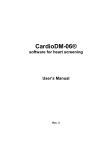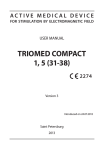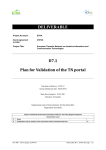Download GDV Sport - GDV Argentina
Transcript
GDV Sport > Introduction GDV Sport Introduction Purpose of the program System requirements Recommended computer configuration Training level of a user Working with program General description of the program Adding an entry of a new subject data Loading GDV-images Capturing GDV-images Calibration Group calibration Noise filtration Pseudocoloring modes Correction of the center and ellipse for the GDV-image of finger GDV-Image menu Data table Summary Additional information Printing out GDV images Saving printed documents GDV Sport > Introduction GDV Sport > Introduction > Purpose of the program Purpose of the program The GDV Sport program is designed to evaluate the psycho emotional status parameters expressed as peer review diagnostic decisions and integral indices reflecting the energy-functional level of human body based on GDV images of human fingers. The calculated parameters and indices express the potential of “successfulness” in the subject’s activity. The program is intended for evaluating the potential successfulness and efficiency of athletes and staff members of companies. The individual rating of a person in the group is based on these characteristics. The method is based on high correlation (correlation coefficients are more than 0,85) of the indicated parameters and indices calculated independently by means of tests and peer review decisions, with geometrical and brightness characteristics of GDV-images. The demo version makes it possible to work only with built-in data; the functions of creating, loading and saving files of subjects are blocked; you also can not load GDV-images from disk or start the GDV Capture to capture these files. The program can simultaneously carry out the data processing for several subjects with a possibility of having several GDV captures for each of them (e.g., taken on different dates). A GDV capture is one or two sets of files of GDV-images of fingers taken with and without filter. In this program only GDV-images without filters are required. The list of captures and personal data of the subject (name, gender, age, etc.) are saved in the file or on the disk. Therefore to process the subject’s data it is necessary either to create a new file, or to download the previously created one and then add the new capture. When you want to close the program or delete subjects from the list, a request will be made if you need to save all changes during this session Thus a typical working procedure looks as follows: 1. Create a new file or download the existing one; 2. Add the new capture; 3. Download the subject’s GDV-images without filter; 4. Calibration (if this procedure has not been carried out before); 5. Check settings of noise filtration, pseudocoloring mode, and if necessary, introduce your corrections; 6. Corrections of inner ellipses; 7. Processing and analysis of the obtained data; 8. Printing and saving the results. GDV Sport > Introduction > Purpose of the program GDV Sport > Introduction > System requirements System requirements The program can be operated in the following Microsoft Windows operating systems: Windows 2000 Windows XP Windows Vista Windows 7 Recommended computer configuration Recommended computer configuration: 32-bit (x86) or 64-bit (x64) processor with a clock speed of 1 gigahertz (GHz) or higher; 1 gigabyte (GB) (32-bit system) or 2 GB (64-bit system) memory (RAM); 16 gigabytes (GB) (32-bit system) or 20 GB (64-bit system) hard disk space; graphic device DirectX 9 or higher. Training level of a user Training level of a user: user should have skills of work with Windows OS GDV Sport > Introduction > System requirements GDV Sport > Working with program Working with program General description of the program Adding an entry of a new subject data Loading GDV-images Capturing GDV-images Calibration Group calibration Noise filtration Pseudocoloring modes Correction of the center and ellipse for the GDV-image of finger GDV-Image menu Data table Summary Additional information Printing out GDV images Saving printed documents GDV Sport > Working with program GDV Sport > Working with program > General description of the program General description of the program The interface of the GDV Sport is arranged as a dialog containing consecutively switched pages. Part of pages is available only after loading or processing of data. The program interface is designed in such a way that the user can consecutively realize construction and visualization of GDV Sport in accordance with standard analysis procedure. When the program is launched the start page is displayed from where the user can start working: When you select the User Manual button, you will see the description of working with programs. The menu item About program will display the data on the installed program version, time and date of its issue, the hardlock number, and there is also a possibility to change the language of the user interface to any of the supported ones without re-installing the program. To do this you need to check the required language and restart the program. The interface language will change for all programs in the package. When you select Start work click the left mouse button to go to the next page Subject list. In the upper right part of the page Subject list there is the menu of the program. When you click on the button Page the menu will appear with a list of all pages where you can arbitrary switch to other pages of the program. The current page is checked; you can choose another one with the left mouse button but you need to consider that part of pages will be available only after the loading or processing of the GDV-images. You can switch between pages during work using buttons Previous and Next in the menu Page or in the lower right part of the page Subject list. If GDV images are loaded there is an opportunity to switch between necessary pages in the menu Page. If you press the button Action a menu will show up with a list of possible actions on this page including both operations common to all pages of the program (“New subject”, “Load subject’s data”, etc) and specific operations for the current working window. For example, “Group calibration” – this option allows recalibration of gdv images which were calibrated earlier with new algorithm of calibration. When GDV images are highlighted it is possible to go to the next page by clicking on the button Next . If you press the button Action a menu will appear again with a list of possible actions on this page. The list of possible actions on this page including both operations common to all pages of the program (“New subject”, “Remove subject from list”, “Load subject data”, etc) and specific operations for the current working window. For example, “Edit capture data” option allows changing and adding of comments, name of a capture, etc. The button Next makes it possible to go to the next page GDV-images if GDV images are loaded. If you press the button Action a menu will appear again with a list of possible actions on this page. The list of possible actions on this page including both operations common to all pages of the program (“Calibration”, “New subject”, “Close”, etc.) and specific operations for the current working window. For example, “Information about the last calibration” – this option allows viewing all parameters of the latest calibration of the capture. The Programs button makes it possible to start any program from the GDV Software package installed on the computer. When the selected program is launched the files of subjects open in the current programs are automatically loaded into it. Further on during work there will be automatic synchronizing of the altered data among all programs to where the altered subject’s file is loaded. GDV Sport > Working with program > General description of the program GDV Sport > Working with program > Adding an entry of a new subject data Adding an entry of a new subject data On page Subject list there are two lists: the upper one is responsible for the information about subjects and the lower one for the information about captures assigned to each of subjects loaded into the upper list. To work with the program it is necessary to add the information about a new subject into the upper list: press the button New subject (highlighted with the color in the figure). The subject’s personal data and the GDV-images file list are saved in the file with the .sbj extension. The file is created on the disk, and its content is updated at the moment when you finish working with the program. Inside, the file contains references to the files with GDV-images. That is, to transfer the information onto another computer you need to copy the required .sbj files together with the appropriate files with GDV-images keeping their arrangement with reference to each other in the directory structure. For the convenience of the data storage and transfer to other computers, it is recommended to keep a certain structure of subject data folders on the disk. In particular, the following example, schematically displayed, is very convenient. In this case to transfer the information about, e.g. Adam Smith you need just to copy the folder Adam Smith with all its contents and the file Adam Smith.sbj. If there is no need to transfer the GDV-images you can just copy the *sbj file. In such case the program will enable you to preview the previously calculated data but reprocessing will be inaccessible. When you press the button New subject the subject’s personal data window will show up. The file name with the .sbj extension to where the subject’s data will be saved is formed by the program automatically based on the subject’s name and the current path to the GDV data base. This path is normally selected by the user when installing the software and it is not to be changed further on. However, using the button Browse... you can indicate a new path to the GDV data base. In the upper part of the window enter the subject’s personal date: name of subject – in the line Name (e.g. Smith), indicate the date of birth, select sex, and, if necessary, put down your comments to this subject. Button enables to enter or edit the date of birth using the calendar. In the lower part of the window there are the control elements that enable to add GDV captures for the given subject. By default, it will be named Capture 1. If necessary, you can enter the name corresponding to the specific character of the test (e.g, before and after treatment). Right from this window, using button Load GD-images , you can indicated the path to the GDV images with or without filter if the images have already been captured before and saved to disk. Besides, you can start the GDV Capture program to capture GDV images by button Capture GDV-images . The line Date is filled out automatically after loading or capturing GDV images. Enter additional information about capturing in the field Remark. When you finish entering data press Done , and on page Subject List there will show up the entries about the subject and the newly added capture. Before the subject’s name and names of captures there are checkmarks to check/uncheck the processing of a single subject or capture. It means that you can process/view not all loaded ones but only selected sets of captures, and not only loaded subjects but only selected ones. To check/uncheck you need to double click the left mouse button. To work with the upper list the following buttons are provided below the list. The button Load subject enables to load information about the subject from the previously saved file. The Load per list button enables to for a list of files of subjects and to load this data into the program from the window Files list composing . The window shows a list of files with extension .sbj, which need to be open. You can edit the list using the following buttons: enables to add to the list the files with .sbj extension from the selected folder on the disk; deletes all selected files with .sbj extension from the list; deletes all files with .sbj extension from the list. Using the Folder pattern and File name pattern you can load into the list not all files but only those that meet a specific condition. In these input fields you can enter any part of the folder or file name. You can also use the two special symbols "*" and "?". "*" means any number (including 0) of any symbols. "?" means just one symbol. For example, you have a set of files of 10 fingers and you need to open the files with fingers of the right hand taken with filter. To do it you type *Filter* in the Folder pattern field, and type ?R* into the File name pattern (naturally, you need to name the files and folders on the disk in an appropriate way). Then when you scan the selected folder, only the required files will be loaded into the list. When you have finished selecting the parameters press ОK . Use the button Edit data to enter changes in the personal data of the selected subject. The button Remove from list enables you to remove the selected recording about the subject from the program. This action does not result in data file removal from the disk but only increases the memory space. Using the button Clear list you can delete all loaded data from the program memory. To work with the lower list the following buttons are provided: Add capture – to add a new capture for the subject selected in the upper list; Edit data – to introduce changes and to add comments to capture selected in the lower list; Remove capture – to delete capture selected in the lower list; To save changes press Save changes... To switch to another GDV-image page use the button Next . GDV Sport > Working with program > Adding an entry of a new subject data GDV Sport > Working with program > Loading GDV-images Loading GDV-images Loading of GDV images is done on the GDV images page and also in the subject’s window with the Load GDV images button (it is highlighted with the color in the figure). The files of GDV images are to have in their name the finger indices 1R - 5R, 1L - 5L. To load GDV-images you need to press the button Load GDV-images in the shown-up window and indicate the path to the folder where the GDV-image set is stored, then press the buttons Select all and Open . The pictures of the subject’s GDV-images are loaded into the GDV-image window. GDV-images taken without filter are loaded into the program. Use the Calibration button for calibration of the loaded GDV-images. Use the button Print GDV-images to print out the pictures of the loaded GDV-images with an overlay of sector division by Korotkov. Use the Load GDV-images button if you want to reload GDV-images. GDV Sport > Working with program > Loading GDV-images GDV Sport > Working with program > Capturing GDV-images Capturing GDV-images On page GDV-images there is the Capture GDV-images… images from any program of the GDV Software package. button that makes it possible to capture GDV- The GDV-image capture process is carried out in the GDV Capture program. When you save the captured GDVimages in this program the following structure of folders on the disk will be automatically created: ... <Subject 1>.sbj <Subject 1> (GDV Images) <Name of capture 1> GDV-images without filter 1R.bmp 2R.bmp 3R.bmp … GDV-images with filter 1R.bmp 2R.bmp 3R.bmp … The lines containing in < > will be replaced by data input by the operator when creating the subject’s account and during GDV-capturing. Until the GDV Capture is closed the work of the program from where the call is made will be blocked. After saving the captured GDV-images and closing the GDV Capture program the images will automatically load to the GDV-images window. The protocol of capturing GDV-images is described in details in the instruction to the GDV Capture program. GDV Sport > Working with program > Capturing GDV-images GDV Sport > Working with program > Calibration Calibration Calibration of GDV devices is the process of registration of number of GDV images of test-object and processing of the images with the purposes of control of technical state of the GDV camera and for the analysis of glow area of test object which is necessary for proceeding in different programs of GDV Software. You need to perform calibration in the following cases: Before starting to work with a new GDV device. When you connect the GDV device to a computer that has not been used for calibration. After switching from the AC/DC adapter 110-240V/12V to the battery (and back). When you bring the GDV device from one room to another or outdoors and back. When the climatic conditions in the room where you capture GDV-images change: if the temperature difference is more than 5ºC or humidity difference is more than 10 %. In presence of an outer electromagnetic radiation source near to the GDV device or when the GDV device is taken to a place with normal or low electromagnetic noise level from a place with high electromagnetic noise level. Also, once in 6 months. The calibration process begins with capturing or loading GDV-images of the test object. You will need no less than 10 GDV-images of the test object for processing (the first 5 GDV images should be recaptured). Before processing you need to save all GDV-images. It is important to make sure that GDV images of the test object have no defects, for example, due to misplacement of the test object, illumination or dusty inner circle, etc. Such defects can distort calibration data which will make it impossible to obtain reliable information in the GDV image processing programs. To carry out calibration you need to press Calibration… in the left lower part of the GDV images window. The program GDV Capture will be launched in the calibration mode. A more detailed description of calibration process, loading or capturing GDV-images see in the instruction to the GDV Capture program in section Working with program GDV Capture. GDV Sport > Working with program > Calibration GDV Sport > Working with program > Group calibration Group calibration Beginning from version 2.7.0 of the GDV Capture 2 program the algorithm of obtaining calibration data was considerably improved, while the format of saving information and the set of the calculated parameters were not changed. Therefore, if you process GDV-images that were previously recorded by an earlier version of the GDV Capture 2 (earlier than 2.7.0) in the new versions of GDV Software (beginning from 2010) the results will be incorrect. To avoid this it is necessary to recalculate calibration data in the latest version of the GDV Capture 2 program and to save these data into GDV-image files. You can do it in two ways: 1. For one selected series of a single subject: 1. Load the sbj-file of the subject into any program of the GDV Software package working with the extension .sbj (GDV Diagram, GDV Energy Field, etc.). 2. Go to the GDV-image page and select the required series. 3. Press Calibration… in the lower left-hand corner of the program window, or select the item Calibration… from the menu Action. 4. The GDV Capture 2 program will start. For further work press OK of the warning pop-up window. 5. Press Load GDV-images in the upper left-hand corner of the program window and select GDV-images of the test object that need recalculation. 6. Press Calculate and then Save calibration results and close the GDV Capture 2 program. 7. The renewed calibration data will be automatically recorded into all GDV-images of the series that you see on the screen (both with and without filter, if any). 2. For an arbitrary set of GDV-images: 1. Make sure that all programs of the GDV Software package are closed 2. Run any program of the GDV Software package (except GDV Capture, GDV Viewer, GDV Scilab) 3. Go to page of the list of subjects. DO NOT LOAD sbj-files. 4. Select in the menu Action the item Group calibration… 5. The GDV Capture 2 program will start. Press the Load GDV-images button in the upper left-hand corner of the program window and select the GDV-images of the test object that need recalculation. 6. Press Calculate . 7. Then press Save calibration results the GDV Capture 2 program will close. 8. The window with a list of GDV-images into which the renewed calibration data needed to be recorded will open. Press Add all files from selected folder to select one or several file from any folder, or press Load from folder to load all GDV-images from the selected folder (the folder is scanned recursively). 9. Press OK : the new calibration data will be recorded into all GDV-images from the list. 10. Save the data with the new calibration. GDV Sport > Working with program > Group calibration GDV Sport > Working with program > Noise filtration Noise filtration The window Noise filter parameters is opened using the button Noise in the upper part of the Dynamic GDV-images page. A GDV-image is a number of points (pixels) each of which is characterized by the glow intensity – a value within 0 - 255. Zero intensity corresponds to the absence of glow in the given point, and 255 indicate maximal glow intensity. The GDV-image spectrum is the function that determines the number of points with specified intensity. Fig. shows a typical GDVimage spectrum. The horizontal axis shows the intensity and the vertical one the number of image pixels with preset intensity. Any video camera used to register GDV-images has a certain error of performance. Therefore the images contain evenly spread “noise” points of low intensity. The figure shows the part of spectrum corresponding to there noise pixels in grey. The blue color indicates the spectral region corresponding to the brightest and most informative point of gas discharge glow around the subject. The video camera performance error is not the only noise contribution to GDV-images. It also may be dirt on the work surface of the instrument. It may result in separate bright spots or fragments that also should be filtered. As a result, noise filtration of GDV-images is carried out in two stages. First, you need to remove pixels whose intensity is equal or less than a certain limit. There are two ways of setting this limit: 1. The limit is set directly– a corresponding parameter of the program is called «absolute noise level»; 2. The limit is determined automatically for each image by a certain characteristic of the GDV-image spectrum. The latter method is regulated by the two parameters – «relative noise level» and «basic intensity». A relative noise level determines the percentage of the limit value for filtration calculated from the selected basic intensity. There are 5 options of basic intensities: 1. Average – an average intensity calculated by analysis of all points of image; 2. Average + RMS – an average intensity of all points of image plus standard intensity deviation; 3. Median – a median of the image points intensities; 4. Peak – the most frequently met intensity value; 5. Threshold – a value exceeding the intensity peak (the number of pixels containing this value is less than 1% of the total amount of image points). At the second stage of filtration a list of image fragments is built – groups of glow pixels situated nearby (the principle of 8connectedness is used: two points are neighboring if their coordinate values have not more than one-unit difference, i.e., the neighboring of the given points are those being in one of the eight nearby positions) For each fragment the area is calculated, i.e., the number of pixels in it. Then you need to remove from the GDV-image all fragments whose area is smaller than the specified one. It is regulated by the parameter «minimal fragment area». The value of this parameter is 10 by default and usually does not require any changes. For the convenience of processing GDV-images of liquids (that may splash during a discharge), and also if there is edge flare (external lighting), another parameter has been introduced, - the «working radius». If this parameter is non-zero, all pixels whose distance to the glow center exceeds the specified value are removed. It should be emphasized that during the filtration procedure there is no physical removal of information from images, all further calculations in the program are done as if all filtered pixels had zero intensity. Therefore you can change the noise filtration parameters any time, not losing the data on noise pixels. The noise filtration parameters settings are carried out by the user. The two main factors to select these parameters are the type of the used GDV Camera and specific features of the recorded GDV-images. In the Operation Manual to the GDV Camera you will find the recommendations helping to determine the correct parameter values. You need to follow the principle of selecting the most contrast part of the glow that can usually be seen with a naked eye. It is also important (when you are registering the test object images) to ensure such filtration parameters that the inner part of the glow would not contain noise pixels. For the convenience of selecting optimal parameters of noise filtration the program can switch to different types of image pseudocoloring. You can use the following way to control the correctness of the chosen parameters: 1. Set the «intensive» or «energy» palette for loaded images; 2. Select the noise filtration parameters so that to avoid a large number of yellow dots; 3. Switch to the «initial image» palette; 4. Switch off the display of the filtered points; 5. Make sure that the visible peculiarities of the subject’s glow have not disappeared from the screen; 6. Switch to the «monotonous palette»; 7. Make sure that the bright-blue dots do not fill the entire or almost entire glow area; 8. If necessary, repeat the procedure. Naturally, the procedure of selecting the parameters is done only once using several samples of GDV-images of fingers and GDVimages of the test object captured with the given GDV Camera. Several parameters of noise filtering are offered in the program: 1. Absolute noise level – removal of all the image points whose intensity is lower or equal to the given noise level. It is recommended to select the value individually for each session of recording within the limits from 10 to 60. 2. Relative noise level (%) – the program automatically selects absolute noise level on the basis of the given percent of the value of base intensity. This algorithm selects the level of noise for each GDV-image frame individually. Base intensity is calculated on the basis of the analysis of histogram of image spectrum. Statistical characteristics of spectrum are taken as the values of base intensity. These characteristics correspond to the spectrum average value plus the value of its RMS, average value of spectrum, median of spectrum or peak of spectrum. 3. Minimal fragment area – removal of fragments of glow with the glow area less than the given minimal area of fragment. On default this parameter is 30. 4. Working radius – removal of all points of the image whose distance from which to the glow center is bigger than the given working radius. The glow center is either calculated automatically, as the center of gravity of all the glow points, or set by the user after manual correction of the glow center. The same value of coordinates of the glow center is used for all the frames of video file. 5. Intensity correction – the intensity of all pixels of a GDV image increases or decreases by the same value that is automatically calculated by the program, so as to bring the characteristics of the image spectrum most closely to the characteristics of the spectrum of test object GDV images taken during calibration. Press OK to activate new parameters. The loaded GDV-images are automatically filtered from noise under new parameters and are renewed in the screen. GDV Sport > Working with program > Noise filtration GDV Sport > Working with program > Pseudocoloring modes Pseudocoloring modes You can view GDV images in various pseudocoloring modes, which enables to study the peculiarity of development of gas discharge more accurately. Pseudocoloring is only represented in the programs of GDV Software complex. All GDV images are saved on the disc in original palette of 256 tints of grey. You can switch one pseudocoloring mode to another in the upper left corner of the page. The following types of pseudo-coloring are provided in the program: 1. Original image – image as it was obtained from video camera and saved in AVI-file. Gray color palette containing 256 shades of gray (from black to white) is used; 2. Inverted image – inverted gray color palette is used, containing 256 shades of gray (from black to white). Particular small details and thin streamers are better seen in this palette than in the initial image; 3. Intensive palette – image points are colored in one of eight colors. The brightest glow points are colored in the shades of blue, less bright points are colored in the shades of red. Points, the intensity of which is higher than the noise level, but lower than the base noise level for the given frame, are colored in yellow. All image points removed by noise filtration are shown in white; 4. Solid palette – all image points removed by noise filtration are shown in black color, the rest of the points are shown in a monotonous bright color. Use this palette analyzing sector’s glow area and glow area of the whole image in order to avoid optical illusion, which can occur if some points are not seen well, as the coloring is similar to the coloring of “noise” points; 5. Blue palette – color palette containing 256 shades of blue (from black to bright blue) is used. Points with minimal intensity of glow are shown in dark (almost black) shades, points with maximal intensity of glow are shown in bright (almost blue) shades. This palette displays the glow similar to the way it can be seen in instrument’s electrode by the naked eye; 6. Energy palette – the image points are colored in one of the nine colors. The brightest glow points are colored in blues, the less bright ones are colored in reds, oranges and violets. All image points removed by the noise filtering algorithm are displayed in white. GDV Sport > Working with program > Pseudocoloring modes GDV Sport > Working with program > Correction of the center and ellipse for the GDV-image of finger Correction of the center and ellipse for the GDV-image of finger Determination of the ellipse and glow center is built automatically when the GDV-grams are load-ed. In most of the cases the contour almost absolutely repeats the finger contour. However, sometimes the glow has outbursts and dark areas, as a result of which the finger contour built automatically is not precise and requires manual correction. In this case the contour can be manually adjusted: the position of the center and the finger orientation can be corrected in order to have a more precise energy field picture. In order to correct the finger center position, move the mouse cursor to the displayed GDV-gram center, press the left button and move the cursor keeping the right button pressed. The finger orientation on a GDV-gram can be corrected in a similar way. In order to do that, move the cursor to one of the displayed GDV-gram axes, press the leftt button and move the cursor keeping the left button pressed. The kept axis will be rotated against the GDV-gram center. In order to correct the contour, mark the corresponding GDV-gram, move the cursor to touch the axis which will be used for correction, and keeping the keyboard CTRL button pressed move the contour border. Besides, sector division of the corresponding finger is superimposed on the GDV images. Detailed information on the GDV image can be obtained using the mouse: when you move the cursor over the image the information is displayed in the lower part of the window. when you press the right mouse button the information is displayed in the pop-up window. GDV Sport > Working with program > Correction of the center and ellipse for the GDV-image of finger GDV Sport > Working with program > GDV-Image menu GDV-Image menu Contextual pop-up menu can be called for any loaded GDV-image. Press right mouse button in the line showing frame’s number and path to the file. Contextual menu appears. It consists of the following items: Menu item Operation Copy to clipboard Copies the frame, being in the screen, to the clipboard, taking into account coloring, sectors and viewing Fit to window Fits maximal quantity of GDV-images in the screen simultaneously (the quantity of images in the screen depends on the monitor resolution) Set maximal enlargement Scales up the selected GDV-image for the whole window Zoom in Scales up the selected GDV-image image Zoom out Scales down the selected GDV-image image Print all images... Calls the Preview window Print image Calls the Print preview window and prints out the selected GDV image Fit ellipse automatically The program automatically recalculate inscribed ellipse overriding previously made manual changes for single GDV-image or for all loaded GDV-images Turn GDV-images upside-down Rotates GDV image on 180° Mirror horizontally... GDV-image The image is a rectangular matrix of points of the form I [x, y] with size w by h."Mirror GDV-image horizontally..." means to transform the image so that I [x, y] will take the position I [wx, y] Save colored images Save GDV-images in the form of their display on the screen (taking into account current coloring type, sector fragmentation, etc.) Compute average image Processes averaged image and asks to save it View Calls GDV-image real size view window GDV Sport > Working with program > GDV-Image menu GDV Sport > Working with program > Data table Data table The Data table page contains brief numeric information on basic parameters calculated in the GDV Sport program. These data are presented in the Rating table. The Rating table consists of lines with parameters calculated for each subject and columns containing the following information: 1. N – the ordinal number of the table line; 2. NAME – first name, Middle name and Last name of the subject; 3. Point – its meaning is from minimum 1 to maximum 10. It characterizes the overall condition. Is has a direct relationship with the parameter Energy Potential; 4. Energy potential (EP) – the parameter characterizing the relationship of the physiological and emotional state of the athlete. It is calculated as a percentage (maximum 100%).EP is the characteristics of the subject’s functional energy level for the period of study. The higher EP, the higher the potential reserve of the subject, or the competitive readiness level for athletes. High EP value characterizes purposefulness, stress resistance, high movement activity and a stock of potential reserves. 5. Stress background (SB) - the parameter characterizing the level of anxiety, stress. SB within 0-2 – a totally calm, completely relaxed person, which may be the result of several factors: a deep meditation, complete inner peace, the influence of psychedelics, a deep sleep in a quiet phase, chronic depression, etc. SB 2-4 – a normal quiet state. SB 4-6 – an excited state characteristic of active work, excitement, intense activity. SB 6-8 - at least four possible situations: a response to a previous stressful situation (an unpleasant conversation, illness, failure in the training process, driving in stressful conditions, etc.); increased nervousness or stress accumulated over long periods of time, emotional stress, vegetative dysfunctions; people with a special type of mentality that can quickly switch from the state of extreme excitement and nervousness into a quiet state; the state of overtraining, fatigue, danger of injury. SB in the range of 8-10 - a very high stress background, the peak of excitement The data table can be saved to a text file or printed out. When you print out the rating table you can indicated the name of the group to which the subjects refer (e. g., swimming). The entered names are saved and you can select them afterwards. If the name of the group is not obligatory you need to press Cancel . GDV Sport > Working with program > Data table GDV Sport > Working with program > Summary Summary The page Summary contains a table where the qualities of the following categories are mentioned: Sport valuable merits Activity - a subject’s ability to change the situation or an attitude to it in the absence of the definite prognosis of its results but continuously taking into account the degree of its efficiency. Purposefulness - a psychoemotional state characterizing readiness and emotional motivation in reaching the goal. Self reliance - a volitional quality that shows in calm perception of his own abilities and advantages by the subject. Stress resistance - the constellation of personal qualities which enable the subject to stand high intellectual, volitional and emotional overloadings due to peculiarities of his professional activity without harmful after-effects for himself and other people. Self regulation - regulation - (from Latin regulare – to bring to order, to adjust) – expedient functioning of living systems of various levels of organization and complexity. Mental self-regulation is one of the levels of regulating the activity of theses systems expressing the specific character of mental properties of reflection and modeling the reality which realize it, including the subject’s reflections. Before nosologic changes Introspection - observation of one’s own mental life (going deep into one’s own thoughts). Unsolvable dreams - an effort to find a solution of unsolvable problems at subconscientious level during sleep. Unmotivational anxiety - a symptom of psychoemotional disorder. Deterioration of efficiency - a decrease of an ability to perform expedient activities at the given level of efficiency during a certain time period. Irascibility, irritability - a non-controlled inadequate psychoemotional subject’s response to exogenous irritants. Dysadaptation states Troubled-hypohondriacal states - a depressive psychological disorder (with obsessive and overvalued alarms referred to one’s health. Tendency to solitude - a psychoemotional state characterizing a state of depression both endogenous (without any evident reasons) and reactive (response to psychotraumatic reaction). Vegetative dysfunction - it is combined with emotional disorders and expressed in vegetative manifestations: giddiness, sweating, chill, shivering, arterial pressure variations, lack of air. Energy deficiency state - states indicate insufficient energy supply of functional activity of body and systems. The state of energy deficiency can be attributed to total breakdown, dysfunctions of separate organs or systems, overfatigue, neuro-psychic stress, over-training. In this state the subject can function normally, in particular, an athlete can show good results, however a long period of such state leads to development of negative processes on psycho-physiological or somatic level. Necessity check up - at the moment of measurements the subject is under stress which makes it impossible to adequately evaluate his psycho-physiological readiness. The given situation requires a more detailed psychological and medical examination. In the table "+" marks the qualities which by the result of processing GDV-images are mostly pronounced for the subject. Press Print… to print out the obtained data. Press Save... to save the results. Press the button Go to the subjects’ page to return to the page with the List of subjects. GDV Sport > Working with program > Summary GDV Sport > Working with program > Additional information Additional information On the last page it is possible to correct or add the additional comments to the Subject or Capture. This information will be saved in .sbj file. GDV Sport > Working with program > Additional information GDV Sport > Working with program > Printing out GDV images Print GDV-images The program makes it possible to print out the loaded GDV images with sector division. Press Print GDV images on the GDV image loading page. Before printing the program will open the preview window, from where the image might be printed or saved. There are several buttons in the tool bar of this window: Close – closes the preview window Print... – switches to window "Print setup", followed by printing << >> – enables to view the previous page and next one |<< >>| – enables to view the first page and the last one Safe to file – enable to save the file of the printed page in Windows Bitmap (extension BMP) or Windows Enhanced Metafile (extension EMF) formats 60% – changes the scale of the preview page Information on the number of pages is shown in the window status bar. After pressing button Print window Print setup appears. If you have a color printer, the printer is automatically set for color printing. "Landscape" page setup is given by default. GDV Sport > Working with program > Printing out GDV images GDV Sport > Working with program > Saving printed documents Saving printed documents Any document (a graph or GDV image) that is formed in the program can be saved from the Print preview window. To do this press the button Save to file in the upper part of this window. The type of file is Windows Enhanced Metafile by default (EMF extension), but you can also select Windows Bitmap (BMP extension). It is advised to use the EMF format for saving pages, as, first of all, images occupy much fewer space on disk in this format than in BMP format. Secondly, when these images are scaled in documents (for example, in Microsoft Word) distortions are minimal. GDV Sport > Working with program > Saving printed documents








































































